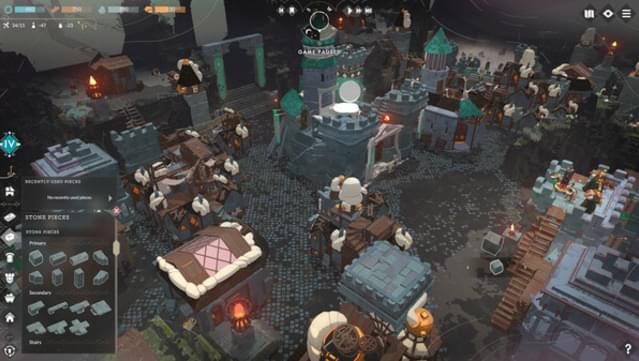
Digital Sun Games’ Cataclismo promises to be a great game. It’s a city-building, real-time strategy hybrid title with gameplay inspired by Lego, Warcraft III, and Age of Empires II. In the game, players must build multi-storey castles in a fantasy world staffed with soldiers armed with a variety of otherworldly weapons to fend off hordes of monsters.
It’s a notable genre shift for the studio, which had its big break in 2018 with shopkeeper-themed action RPG Moonlighter. According to creative director Vicent Ramirez and CEO Javi Giménez, the change in genre and gameplay came from the team’s developers wanting to move beyond the top-down RPG format.
But look closer and you might see another subtle influence on Cataclysmo. Digital Sun is based in Valencia, a city in the Castile region of Spain, and its name literally means “land of castles.” Ramirez and Jimenez had a fun discussion about how the architecture around them influenced them, and what being aware of this connection means for creativity in game development.
Castle construction is at the core of Cataclismo

While many tower defense-style games like Cataclysmo are designed around the aesthetics of medieval fortresses, the Digital Sun team’s fascination with classic fortress structures bleeds into the game design. Jimenez said the goal was to let players naturally build “beautiful” castles that don’t have to change shape at the expense of function when enemies storm the gates.
This becomes a more challenging task when castle building is as modular as it is here. Ramirez said the building system is inspired by assembling Lego blocks, offering players the opportunity to refine the shape of their buildings. The feature will be comprehensive enough to support a monster-free “creative” mode.
Early versions of the system had a problem that concerned many designers: players drifted into one of two camps: those who enjoyed building beautiful castles, and those who ignored the aesthetics of their base and just built the most efficient monster-busting operation.
In other games, this would be a feature, not a bug. It’s entirely possible that players who make certain compromises to gain power will be rewarded. But that wasn’t what Digital Sun wanted. The next step in developing the castle-building gameplay was to blend these two playstyles so that players who focus on either aspect of base building could do something that would benefit the gameplay.
Keeping the goals of the two players so far apart also contradicts the basic idea of why castles are so appealing. “Real castles are cool because they’re useful in battles,” Jimenez said with a serious look on his face.
He said: Towers, crenellations, moats, gates, concentric castle courtyards, stacked courtyards, and other practical features of real castles are what draw people’s attention to the castle.
But castles don’t look the same in different countries, and it’s here that Castilian castles fit into the visual style of Cataclismo.
Art is shaped by the world around you

Ramirez explained that when developing Cataclismo’s visual style, Digital Sun wasn’t aiming to recreate Spanish medieval architecture. It’s a fantasy game in a fantasy world, which gave them more room for art and gameplay to work together.
But then one day, one of the game’s artists (who is from Russia) came into the studio and said, “All of Cataclismo’s architecture is Valencian architecture.”
“This happens to us completely unconsciously.” Ramirez said he and Jimenez agreed that the similarities only have to do with castles creeping up in your head when making a castle game in a region with lots of castles.
There are lessons to be learned from this. The first and most obvious is that Cataclismo has a more striking look because of its unique inspiration. Secondly, when developing a game, the environment can have subconscious influences on us and affect our decisions in the game.
Becoming aware of these influences can be an opportunity to discover what makes our environment unique or to recognize what needs to be changed in the game. I’ve heard developers discuss this topic a few times, and one notable example is Insomniac Games’ redesign of the city in Sunset Overdrive, which doesn’t resemble Burbank, California, but rather the fictional “San Fran Tokyo”.
So, if you’re reading this, go outside and look at the world around you. Is your game similar to this world? Does it need to look more like this? Or less?
This is your decision, but as Cataclismo shows, there is a lot to learn by doing this analysis yourself.

Leave a Reply